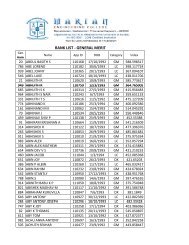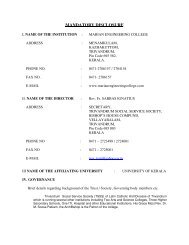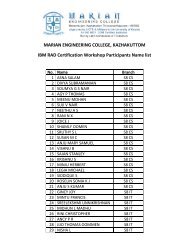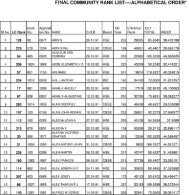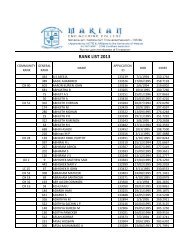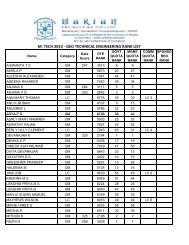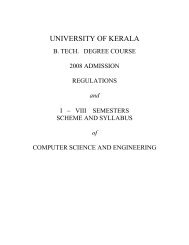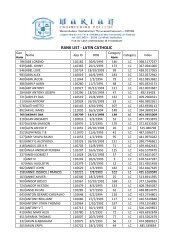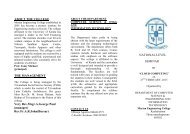UNIVERSITY OF KERALA - College of Engineering, Trivandrum
UNIVERSITY OF KERALA - College of Engineering, Trivandrum
UNIVERSITY OF KERALA - College of Engineering, Trivandrum
You also want an ePaper? Increase the reach of your titles
YUMPU automatically turns print PDFs into web optimized ePapers that Google loves.
08.705.8 Elective III DESIGN <strong>OF</strong> <strong>OF</strong>FSHORE<br />
STRUCTURES<br />
L T P/D Cr<br />
3 1 0 4<br />
Module I<br />
Introduction to Ocean oil gas and other resources – near shore structures - Different types <strong>of</strong> ocean structures<br />
and systems - Gravity, fixed, floating semi submersibles, compliant structure-Tension legged platform and<br />
guyed tower. Design <strong>of</strong> fixed <strong>of</strong>fshore Jacket Platform-Steps in design. Environmental load calculation (wind,<br />
wave, current and tidal) and design parameters. Problems on checking the sufficiency <strong>of</strong> tubular members under<br />
different loading conditions in conformity with the API-Code. Tubular Joints-different types. Analysis <strong>of</strong> Joints,<br />
Stress concentration factor, fatigue failure-SN curves<br />
Module II<br />
Basic principles <strong>of</strong> design <strong>of</strong> concrete <strong>of</strong>fshore platforms - Jack up platforms, Wave forces on large structures-<br />
Froude-Krylov Forces-General theory. Design <strong>of</strong> compliant structures forces & bending moments in floating<br />
platforms Design principles <strong>of</strong> - Tension leg platform Sizing and mechanics –weight estimate <strong>of</strong> TLP.<br />
Module Ill<br />
Mechanics <strong>of</strong> mooring lines-steady state forces in mooring line due to current. Equation <strong>of</strong> static equilibrium.<br />
Integration <strong>of</strong> equilibrium equations –heavy and short cables-neutrally buoyant cables, Pr<strong>of</strong>ile <strong>of</strong> cable line<br />
under all forces considered- Critical angle.<br />
Sub sea pipeline-pipeline safety .Design Process –internal pressure-external pressure. On bottom stabilityobjective-<br />
static analysis. Laying Pipe line - different methods<br />
References:<br />
1. Thomas H. Dawson. , “Offshore structural <strong>Engineering</strong>’’<br />
2. Subrata K Chakrabarti, “Wave Hydrodynamics’’.<br />
3. Subrata K Chakrabarti, “Hand book <strong>of</strong> Offshore <strong>Engineering</strong> (Vol. I & II)’’. Elsevier Science, 2005. ,<br />
Prentice Hall Inc. Englewood Cliffs, N.J. 1983<br />
4. Hsu Teng H., “Applied <strong>of</strong>fshore Structural <strong>Engineering</strong>’’, Gulf Publishing Company Book Division,<br />
Houston, Texas, 1984.<br />
5. Henri O. Berteaux. , “Buoy <strong>Engineering</strong>’’. Umi Research Pr., 1976.<br />
6. George A Antaki, “Piping and pipeline <strong>Engineering</strong>’’, CRC Press / Marcel Dekker Inc., 2003.<br />
Question paper:Duration: 3 Hrs.<br />
The question paper consists <strong>of</strong> Part A and Part B.<br />
Part A is for 40 marks. There will be 8 compulsory short answer questions <strong>of</strong> 5marks each covering the entire<br />
syllabus.<br />
Part B is for 60 marks. There will be two questions from each module. The candidate has to answer one<br />
question from each module.<br />
Note: No charts, tables, codes are permitted in the Examination hall .If necessary the same shall be given along<br />
with the question paper by the question paper setter.<br />
83



